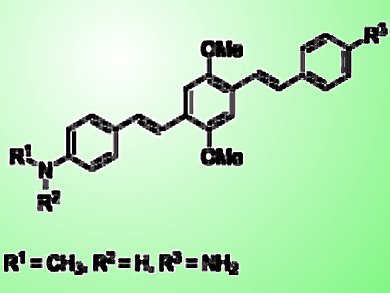The correct transmission of nervous electrical impulses is guaranteed by myelin, an insulating system wrapping nerve fibers. In the spinal cord, the destruction or the malformation of this protective sheath causes paralysis. Monitoring myelin levels is, thus, important to evaluate the efficacy of treatments promoting its repair.
Allison Condie and colleagues, Case Western Reserve University, USA, developed a fluorescent probe to visualize spinal cord’s myelin using two-photon fluorescent microscopy, a technique enabling the imagining of living tissues with a high resolution. The researchers synthesized 4-((E)-4-((E)-4-aminostyryl)-2,5-dimethoxystyryl)-N-methylaniline (pictured) and demonstrated that this compound selectively binds myelin. Moreover, when the scientists injected the probe into mice whose spinal cord’s myelin was destroyed or structurally deformed, they obtained images where pathological myelin forms could be clearly distinguished from healthy ones.
The compound could be, thus, used to monitor the effectiveness of myelin-repair therapies.
- Two-Photon Fluorescent Imaging of Myelination in the Spinal Cord,
Allison G. Condie, Stanton L. Gerson, Robert H. Miller, Yanming Wang,
ChemMedChem 2012, 7 (12), 2194–2203.
DOI: 10.1002/cmdc.201200343




